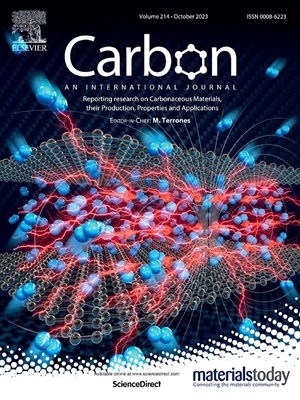Interpretation of wide-angle x-ray diffraction patterns from mesophase pitch-based carbon fibers – a simulation and experimental study
IF 10.5
2区 材料科学
Q1 CHEMISTRY, PHYSICAL
引用次数: 0
Abstract
Carbon fiber is a critical material in a wide range of industries, where it is highly valued for its high specific strength/stiffness, excellent wear resistance, efficient electrical and thermal transport properties, chemical resistance, and low coefficient of thermal expansion. The properties of a specific carbon fiber are closely tied to its structural characteristics at all length scales. In this work, we applied wide-angle x-ray diffraction to a set of heat-treated mesophase pitch-based carbon fibers, with the goal of elucidating the crystalline structures as a function of fiber orientation. To assist with analysis and interpretation of the experimental data, we employed diffraction pattern simulations using the scalar and vector forms of the Debye scattering equation to determine the influence of basal plane orientation, crystalline ordering (turbostratic-graphitic), and basal plane asymmetry on the diffraction patterns. The results presented here suggest that growth of the transverse crystallites in mesophase pitch-based carbon fiber is fixed until graphitization temperatures are reached. The work completed here provides a framework for the analysis of carbon fiber and other oriented carbon-based materials via diffraction.

中间相沥青基碳纤维广角x射线衍射图的解释-模拟和实验研究
碳纤维是广泛工业中的关键材料,因其高比强度/刚度,优异的耐磨性,高效的电气和热传输性能,耐化学性和低热膨胀系数而受到高度重视。一种特定碳纤维的性能与其在所有长度尺度上的结构特征密切相关。在这项工作中,我们应用广角x射线衍射对一组热处理的中间相沥青基碳纤维,目的是阐明晶体结构作为纤维取向的函数。为了帮助分析和解释实验数据,我们使用Debye散射方程的标量和矢量形式进行衍射图案模拟,以确定基面取向、晶体有序(涡层-石墨)和基面不对称对衍射图案的影响。本文的研究结果表明,在石墨化温度达到之前,中间相沥青基碳纤维中横向晶的生长是固定的。这里完成的工作为通过衍射分析碳纤维和其他取向碳基材料提供了一个框架。
本文章由计算机程序翻译,如有差异,请以英文原文为准。
求助全文
约1分钟内获得全文
求助全文
来源期刊

Carbon
工程技术-材料科学:综合
CiteScore
20.80
自引率
7.30%
发文量
0
审稿时长
23 days
期刊介绍:
The journal Carbon is an international multidisciplinary forum for communicating scientific advances in the field of carbon materials. It reports new findings related to the formation, structure, properties, behaviors, and technological applications of carbons. Carbons are a broad class of ordered or disordered solid phases composed primarily of elemental carbon, including but not limited to carbon black, carbon fibers and filaments, carbon nanotubes, diamond and diamond-like carbon, fullerenes, glassy carbon, graphite, graphene, graphene-oxide, porous carbons, pyrolytic carbon, and other sp2 and non-sp2 hybridized carbon systems. Carbon is the companion title to the open access journal Carbon Trends. Relevant application areas for carbon materials include biology and medicine, catalysis, electronic, optoelectronic, spintronic, high-frequency, and photonic devices, energy storage and conversion systems, environmental applications and water treatment, smart materials and systems, and structural and thermal applications.
 求助内容:
求助内容: 应助结果提醒方式:
应助结果提醒方式:


